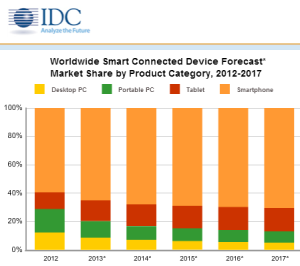The recent write down of the acquired Nokia assets by Microsoft does give many pause to ponder on the future of Microsoft. With Microsoft holding less than 3% of smartphone OS share and with the PC market in slow decline, it is essential for Microsoft to gain mind share in the fast growing smartphone market. And this should happen soon before iOS and Android start using there dominant positions in smartphones to penetrate the enterprise PC market.
The underlying theme for Windows 10 holds much promise: “one unifying platform, one unifying experience” across all personal computing devices ( laptops, tablets and smartphones). But consumers in the smartphone industry will not be swayed by this unification experience argument. And without consumers in the smartphone industry adopting Windows 10, the overall strategy would fail completely.
When Microsoft bought Nokia, I was one of the few who actually thought it was a great acquisition. It allowed Microsoft to have hardware expertise thus giving it more control on building a tighter ecosystem within its Windows phone OS as opposed to the issues faced by Android. But sadly Microsoft has not been able to take advantage of it. Millions of consumers would swear by the build quality of Nokia hardware but hardware alone does not lead to smartphone sales. There were two main issues which Microsoft failed to address after the Nokia acquisition:
1. App Store: Any consumer using a smartphone knows that the Windows store is lackluster in App quantity and quality. Some of the popular apps on the iOS and Android phones are not present in the Windows store and even if some are present, their quality is far less than those on iOS and Android. Microsoft has been calling for more developers to come to its platform but the success rate is very very low.
2. Consolidation of smartphone categories: In the past Nokia made the mistake of rolling out smartphones of every size, feature and price out into the market. This strategy is based on the perception that consumers value a range of offerings when buying a smartphone. But Nokia’s offerings were just too many which lead to huge operational costs in the long run. Microsoft continued that mistake by rolling out numerous Lumia models confusing their consumers and not reducing their operational costs. In addition developers who develop apps do not want to spend a long time testing whether apps work on the various Lumia devices, of varying sizes and features, in the market.
Below I list two steps which Microsoft has to implement immediately to survive in the smartphone industry and the personal computing space:
1. Develop Apps: Microsoft faces a chicken and egg issue. No consumers, so no developers to develop apps, and with no apps there are no consumers buying Windows Phones. Microsoft has to take a tactic from their Xbox gaming division. The Xbox division uses a strategy of developing games though its Xbox Studios and at the same time helping 3rd party gaming studios through financial and manpower resources to develop games on its platform. Microsoft should immediately create Windows Phone Studios to develop high quality Windows 10 Apps and promote them to consumers. At the same time, it should look at the list of top 100-500 apps on iOS and Android, call up the companies which develop those apps and form partnerships to develop similar apps on Windows 10. If it means throwing money on these companies to develop those apps then so be it. ( This financial resource is more essential to Microsoft’s future than the recent $2.5B acquisition of Minecraft. Just imagine how many high quality apps could have been developed to bolster the Windows store). The recent news that iOS and possible Android apps could be ported over to Windows 10 is good news but Microsoft would still need native apps to be developed for the best consumer experience.
2. Categorize your Lumia portfolio: There are just too many Lumia phones on the market with little to no differentiation among themselves. My advice to Microsoft is to categorize the Lumia phones into three distinct categories: Low, Mid and High-end based on price and features. The low-end would address the under $200 range, Mid under $400 and the high-end flagship phone would be priced similar to iPhone. Only 3 phones and no more. This will give enough range for consumers to choose , reduce the difficulty on developing apps by 3rd party developers and reduce the operational costs. But seeing Satya Nadella’s statement recently, I believe Microsoft is trying to concentrate only on a flagship phone and leave the rest of the lower end categories to 3rd party device makers. If Microsoft is trying to do what Google does with its Android ecosystem, then it is even more imperative that Microsoft start creating a robust, high quality Windows App store before 3rd party devices makers even buy into the idea of creating Windows phones.
The Windows 10 launch is coming soon, but if Microsoft does not announce some high quality apps to go along with the launch then the future of the Windows 10 platform is at risk and with it Microsoft’s own global market share in the personal computing space.
